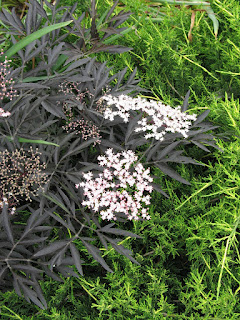
New from Proven Winners a few years back, Sambucus 'Black Lace' almost didn't survive my ruthless culling after it's second season in the garden. I relented at the last second and, because it had shown some signs of promise in its second year, I decided to give it one last chance. Today, I'm thrilled that I had a change of heart and let it stay.
Because most cultivars of the European elderberry don't appreciate the heat and humidity of our southern summers, I had honestly written the plant off before it ever got its roots in the ground. But it was new--and it sure was pretty in the pot--and because I've grown to trust the Proven Winners brand, I decided I needed to give it a try before I cold-heartedly wrote it off without giving at least one season to prove itself. I have to say, that first season was pretty lackluster, but being a knowledgable plantsman and gardener I knew better than to pass judgment after the first year. Sometimes a plant needs a season to settle in. So I pruned sparingly, fed copiously and waited for the results.
By spring of its second year, it was showing a little more promise. It had grown a few long and somewhat wayward shoots the previous summer, but I left well enough alone, only trimming the tips of the branches to (hopefully) help promote some additional side branching and basal growth. It did grow, albeit slowly, and it did have one or two clusters of blooms in its second spring. By autumn, though, I was growing impatient. I liked it, but did I love it enough to give it a third season??? Hmmmm...
For weeks I walked past it in the garden, each time thinking that its day had come and that I would give it a good shovel-pruning and add it to the compost pile where numerous other plants who hadn't made the cut would now feed next year's new garden additions. But every time I raised the shovel, I just couldn't go through with it. Something stopped me and I finally gave in, allowing it one more season to turn my head and show me what it really had to offer. If, however, it wasn't spectacular by the end of the third summer, into the compost heap it would go--no relenting!
I didn't have to wait for the end of the third season because 'Black Lace' has come into its own at the beginning of its third year and has proven once again to this somtimes impatient gardener that once in a while, you just have to hold your horses. Be patient. It's ferny black foliage and soft pink flowers are gracing the garden as we speak--and this little plant has proven to be t-o-u-g-h!!! If you look at the Proven Winners website and read the cultural information for the 'Black Lace' elderberry, you'll see that they say full sun and plenty of moisture, but I've actually had the opposite experience.
My trial plant is located in part shade--good morning sun, actually (which I think is better for it in the South) and is planted immediately under a 12-foot tall sweetbay magnolia (Magnolia virginiana) that sucks every drop of water from every plant within a 10-foot radius. Neighboring plants include Agave parryi, Agastache aurantiaca, Juniperus 'Gold Coast', numerous Sempervivums and Dianthus 'Bath's Pink'--all of which are immensely drought tolerant and growing within 6 feet of the water-sucking sweetbay. 'Black Lace' is not only holding it's own under these conditions, it's thriving. For the first time, the entire plant is covered in clusters of pale pink-white flowers and the new growth is showing tremendous vigor. Strong basal shoots indicate that it's really going to "bulk up" this year and by the end of summer I fully expect that it will be as beautiful as I had cautiously hoped it would be.
I sure am glad it isn't sticking roots-up out of the compost pile!
2 comments:
I've seesawed back and forth about getting one. Wild elderberry grow well all around me so I'm sure it would do ok. Our summers are frequently droughty and the thickets are always in full sun. I was afraid it would be another one of those black leaved shrubs that would look sunburned by the end of July.
Marnie
I was so pleased to read about your results with this plant. My history with it is similar, but I'm only in the second year. I'm going to patiently wait for next season and see what happens!
Post a Comment